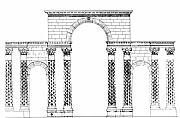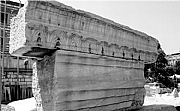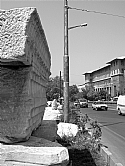Projects & Buildings

| Architect | Dr. M. Sinan Genim / Belma Barış Kurtel |
| Assistants | Özgen Esen / Zeynep Çelebi |
| Employer | Present to the Governorship of İstanbul |
| Project Year | 2005 |

Various ideas have been put forward about the settlement history of Istanbul. However, it is precisely known that the peninsula of Istanbul was settled long before the colonists from Megara arrived. One of the settled areas is the city of Lygos, of which we know very little. The early city of Lygos was named as Byzantion after the colonists from Megara became dominant in 660 B.C. It survived as a city state 800 years and was conquered by the Roman Emperor Septimus Severus [193-211 A.D.] in 196 A.D. He ruined the city due to its struggle against the siege. Afterwards the city became a part of Marmara Ereğlisi [Perinthos]. However, the emperor decided to repair and build new structures in the city due to its geopolitical and geographical position. The name of the city changed to Antonia [Antoninia] during this period.
The fortification walls that extended the settlement area by some 100-110 hectares were made between Eminönü and Ahırkapı. Building activities that began during the reign of Septimus continued during the reign of Caracalla [211-217 A.D.]. The Goths and the Heruls that threatened the whole Aegean region between 258-269 A.D. attacked Antonia [Byzantion] and caused much damage in the city. Battles between Maximinus and Licinius [312 A.D.], Licinius and Constantinus [324 A.D.], together with the sieges at the beginning of the 4th century A.D. also gave extreme damage to the city. Constantinus began the reconstruction of the fortification walls in 324 A.D., and the same year he renamed the city as Constantinopolis to remind his successes.
Beginning from 324 A.D., disputes between Constantinus and the paganic high class of Rome increased and in 328 A.D. Istanbul became the new imperial center of the Roman Empire. The fortification walls approximately between Cibali and Samatya began to be rebuilt and they caused the city to grow the third time. Two important squares, Augusteion [Hagia Sophia] and Forum Constantinus [Çemberlitaş] were built during this period. In addition, beside the existing buildings [Hippodrome and Baths of Zeuksippos] construction of many monumental official buildings such as the Senate, Million, Praetorium, Capitol were completed.
The city imitated Rome in every little detail. The opening of the city was celebrated in 11 May 330, and the city was named as Nea Roma. The successors of Constantinus continued the building activities for a long time. The Aqueduct of Valens built by Emperor Valentinianus [368-376 A.D.], Forum Tauri [Beyazıt Square, 380-393 A.D.], Forum Bovis [Aksaray Square] and Forum Arcadii [402-421 A.D.] completed at the beginning of the 5th century A.D., survived to the present day and became the symbols of the city.
Forum Tauri [Theodosisus] built on Mese street [Divanyolu] between 380-393 A.D. was a necropolis area of the earlier period of the city. The structuring of the area began in the reign of Theodosius I. [379-395 A.D.]. A huge monumental nymphaion was built during the reign of Valentinianus in 372-373 A.D. The area demonstrates many similarities with the Forum Traianus in Rome. The three naved Basilica Theodasiana, a honorary column including a statue of Thedosius with his horse are situated here. To the west of this column is another column, on top of which stands the statue of Theodosius’ son, Honorius, the emperor of the Western Roman Empire, and to the east is the column with a statue of Arcadius, Theodosius’ other son, the emperor of the Eastern Roman Empire. The most important structure of the Forum Tauri is no doubt the Tetrapylon. Among the buildings that survived from the Roman period in Istanbul, the Tetrapylon is one of the rare buildings, which we can determine the dimensions and the general plan.
According to the restitution, it is 34 m long, 7 m wide. Its central opening is wide, side opening is narrow. Each opening is carried by four columns. It stands on the Mese street. The central opening through which the Mese street continues, is 7 m wide. The height of the keystone is 18 m. The narrow passages are 3.80 m wide, while their keystones are 9.5 m high.
Forum Tauri was decorated with monuments demonstrating that Istanbul was the center of the Roman Empire for a long time. Honorius and Arcadius, the sons of the Emperor Thedosius I., were symbolically the governors of Western and Eastern Roman Empire. However, above the two emperors, their father held the authority as the Roman Emperor and administered the empire not from Rome but from Istanbul. On top of that, it is not the west, but the east, Arcadius the Eastern Roman Emperor, that is the first among the first. Because in a short while he is to become the emperor of all Rome [395-408 A.D.].
The remains of the Tetrapylon, which was first located by English archaeologists in 1927 after a long time, were once again revealed as a result of the breaking down of Simkeşhane during the road constructions between 1957-1958. After the excavations, the foundations, various column pieces, capitals, cornices and pieces of cassetta of the great Tetrapylon were conserved.
Similar triumphal archs can be found at Rome, Verona, Nimes, Athens and Thessalonice [the triumphal arch of Hadrian in Antalya not to be forgotten]. They demonstrate the glory of the Roman Empire. Many emperors and kings imitated the glorious monuments of Rome and built similar triumphal archs during the following centuries. During a period that we spend great struggle to get into the European Union, it will be very useful both in cultural terms and public relations to reconstruct the monument at a suitable place in Beyazıt Square. The construction of the monument will attract attention of the whole world. Not only that, it will demonstrate that we are in the middle of the European society for thousands of years, and that we have made the destiny of this continent both in the periods of the Roman and Ottoman empires. It will also show that the city was the capital of the continent for a time.
We would like to intensify the proposal of the reconstruction of this triumphal arch by a quote of a wise man from a distant past. In his work Mukaddime, İbn Haldûn says: “We see that the states are helpless to demolish the monuments from the Antiquity. Whereas to demolish is much easier than to built from all over. Because to demolish is to get back to absence… Emir of the Muslims! Do not demolish, leave them as you found them, so that those who see them will know that you have the power to conquer the states of the people that built these glorious monuments.”




